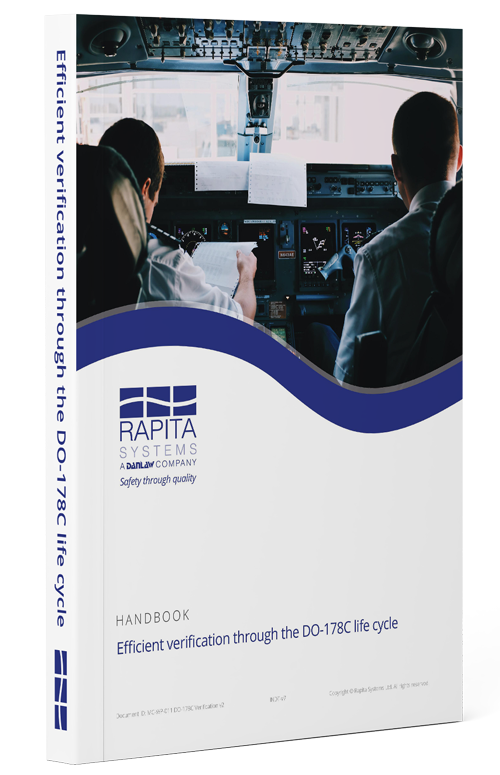Certifying Unmanned Aircraft Systems
The future is here! Uncrewed Aircraft Systems (UAS) have begun to dot the skies and perform operations, from taking aerial photos or making deliveries in urban landscapes to military engagements across geographical boundaries.
But how do we ensure UAS are safe to fly?

UAS Safety Regulations
With the increasing viability and use of UAS, UAVs and drones in recent years, regulations for UAS safety around the globe have begun to emerge.
Airworthiness certification is the main method through which aircraft systems are demonstrated to be safe for operation. Whether airworthiness certification is required for a UAS depends on the characteristics of the UAS, and the operations in which the UAS will be used.
In the USA, aircraft systems must be certified for airworthiness unless one of the following is true 1 :
- The aircraft falls under 14 CFR Part 107 2 . This is only applicable for UAS that weigh 55 pounds or less on take-off.
- The UAS has an exemption from the Secretary of Transportation under 49 U.S.C. §44807 3 .
For any systems that don’t meet one of the criteria above, an airworthiness certificate must be issued by an FAA representative for such aircraft as per FAA 14 CFR Part 21 Subpart H 4 . DO-178C (see below) offers a great framework for software aspects of airworthiness for such systems.


The European Union Aviation Safety Agency (EASA), meanwhile, classifies drones into one of three categories depending on the level of risk for drone operations 5 :
- Open (lowest risk)
- Specific (medium risk)
- Certified (highest risk)
Many low weight hobby drones in operation in the EU today are in the “Open” category. Depending on drone weight, registration may be required, but even where it is, this is generally a lightweight process.
The “Certified” category is for UAS with the highest operational risk. UAS in this category should be certified for airworthiness, with requirements comparable to those for manned aviation (for example similar to DO-178C design assurance methodologies used for civil manned aviation).
The “Specific” category of UAS lies between these two extremes, and while categorized as “medium risk”, risk levels for such UAS fall on a sliding scale including lower and higher risk operations, with operational and airworthiness requirements falling on a similar sliding scale, dependent on risk. The risk category of a UAS in the “Specific” category is determined by using the SORA methodology. This is used to determine the Specific Assurance and Integrity Level (SAIL) for a UAS, which in turn determines the operational and airworthiness requirements for the UAS.
SORA, SAIL, and airworthiness requirements
In UK and the EU, the SORA methodology is an approach used to classify the risk category of UAS in the “Specific” category. It was created by the Joint Authorities for Rulemaking on Unmanned Systems 6 , a multinational and multi-organizational group with over 60 members 7 helping to shape UAS safety regulations across a large part of the globe.
Using the SORA methodology, a ground risk class (GRC) and air risk class (ARC) is identified for UAS operations. Based on these categories, operations are classified with a Specific Assurance and Integrity Level (SAIL, Table 1). 8
The SAIL determines which Operational Safety Objectives (OSOs) need to be met for a UAS.
|
ARC |
||||
|---|---|---|---|---|
|
GRC |
a |
b |
c |
d |
|
≤2 |
SAIL I |
SAIL II |
SAIL IV |
SAIL VI |
|
3 |
SAIL II |
SAIL II |
SAIL IV |
SAIL VI |
|
4 |
SAIL III |
SAIL III |
SAIL IV |
SAIL VI |
|
5 |
SAIL IV |
SAIL IV |
SAIL IV |
SAIL VI |
|
6 |
SAIL V |
SAIL V |
SAIL V |
SAIL VI |
|
7 |
SAIL VI |
SAIL VI |
SAIL VI |
SAIL VI |
|
>7 |
UAS classified in “Certified” category |
|||
|
SAIL Level |
Safety Objective / Failures per flight hour |
Minimum hours of FTB testing |
|---|---|---|
|
IV |
10 -4 |
30,000 |
|
V |
10 -5 |
N/A |
|
VI |
10 -6 |
N/A |
Airworthiness requirements for “Specific category” Uncrewed Aircraft Systems are codified in OSO#04 “UAS components essential to safe operations are designed to an Airworthiness Design Standard (ADS)”. This is not required for SAILs I-III, and is required with low, medium, and high robustness for SAILs IV, V and VI respectively.
Table 2 summarizes the safety objective and approval criterion for SAIL IV – SAIL VI, which are outlined in SORA v2.5 Annex E 9 . In all cases, a competent certification authority is involved in the certification of a UAS, however the role of the authority is different for each SAIL level.
For SAIL IV operations, a Functional Test Based (FTB) approach can be used to meet OSO#04 where evidence is available of at least 30,000 FTB flight hours. This approach cannot be used to meet OSO#04 for SAIL V or SAIL VI operations.
JARUS suggests Airworthiness Design Standards (ADS) that can be used to meet the airworthiness requirements for UAS in OSO#04, such as the EASA Special Condition Light-UAS. Applicants are also free to propose their own ADS. DO-254 and DO-178C, which are used for certification of conventional hardware and software used in avionics systems, are a great choice for the certification of SAIL IV, V and VI, and “Certified” category UAS.
The “Gold Standard” for software airworthiness
For demonstrating on-board software airworthiness, DO-178C (ED-12C in Europe) is the gold standard.
DO-178C and its predecessors have a long pedigree, having been used to demonstrate airworthiness for software used in manned aircraft systems for over 40 years.

Efficient verification through the DO-178C life cycle
The DO-178C guidance defines objectives to demonstrate design assurance, providing a template for activities for UAS certification with the FAA, EASA, CAA, and other authorities. The objectives DO-178C applicants are asked to meet depend on the Design Assurance Level (DAL) of the system, which is based on the risk should software fail.
These objectives include, for example, verification of the software by functional testing, structural code coverage analysis, and worst-case execution time analysis.
Certifying UAS
So DO-178C’s objectives offer a great template for certification activities for UAS, but which objectives and what level of rigor should be applied?
The objectives undertaken for UAS certification should be commensurate with risk should the software fail, and it’s always best to discuss applicable objectives with your certification authority, such as the FAA, EASA, or CAA.

Efficient UAS verification with RVS
Many planes flying today include software verified by the RVS toolsuite. The toolsuite is used and qualified on DO-178C software of the highest criticality, DAL A, across the globe.
- Automated on-host and on-target testing
- Functional testing, structural coverage & WCET
- Proven record on avionics DO-178C projects










References
- FAA. “Certification” faa.gov, 2022, www.faa.gov/uas/advanced_operations/certification.
- The Electronic Code of Federal Regulations. “14 CFR Part 107 -- Small Unmanned Aircraft Systems.” ecfr.gov, 28 June 2016, www.ecfr.gov/current/title-14/chapter-I/subchapter-F/part-107.
- FAA. “Section 44807: Special Authority for Certain Unmanned Aircraft Systems” faa.gov, 2023, www.faa.gov/uas/advanced_operations/certification/section_44807.
- The Electronic Code of Federal Regulations. “14 CFR Part 21 Subpart H” ecfr.gov, 2024, www.ecfr.gov/current/title-14/chapter-I/subchapter-C/part-21/subpart-H?toc=1.
- EASA. "Proposal to Create Common Rules for Operating Drones in Europe" easa.europa.eu, 2015, https://www.easa.europa.eu/sites/default/files/dfu/205933-01-EASA_Summary%20of%20the%20ANPA.pdf.
- JARUS. "Publications – JARUS" jarus-rpas.org, jarus-rpas.org/publications/.
- JARUS. “Members – JARUS.” jarus-rpas.org, jarus-rpas.org/about-us/members/.
- JARUS. “JARUS guidelines on Specific Operations Risk Assessment (SORA)” jarus-rpas.org, 2024, jarus-rpas.org/wp-content/uploads/2024/06/SORA-v2.5-Main-Body-Release-JAR_doc_25.pdf.
- JARUS. "JARUS guidelines on SORA Annex E Integrity and assurance levels for the Operational Safety Objectives (OSO)" jarus-rpas.org, 2024, jarus-rpas.org/wp-content/uploads/2024/06/SORA-v2.5-Annex-E-Release.JAR_doc_28pdf.pdf.

 Rapita System Announces New Distribution Partnership with COONTEC
Rapita System Announces New Distribution Partnership with COONTEC
 Rapita partners with Asterios Technologies to deliver solutions in multicore certification
Rapita partners with Asterios Technologies to deliver solutions in multicore certification
 SAIF Autonomy to use RVS to verify their groundbreaking AI platform
SAIF Autonomy to use RVS to verify their groundbreaking AI platform
 RVS gets a new timing analysis engine
RVS gets a new timing analysis engine
 How to measure stack usage through stack painting with RapiTest
How to measure stack usage through stack painting with RapiTest
 What does AMACC Rev B mean for multicore certification?
What does AMACC Rev B mean for multicore certification?
 How emulation can reduce avionics verification costs: Sim68020
How emulation can reduce avionics verification costs: Sim68020
 How to achieve multicore DO-178C certification with Rapita Systems
How to achieve multicore DO-178C certification with Rapita Systems
 How to achieve DO-178C certification with Rapita Systems
How to achieve DO-178C certification with Rapita Systems
 Certifying Unmanned Aircraft Systems
Certifying Unmanned Aircraft Systems
 DO-278A Guidance: Introduction to RTCA DO-278 approval
DO-278A Guidance: Introduction to RTCA DO-278 approval
 Avionics Certification Q&A: CERT TALK (with Consunova and Visure)
Avionics Certification Q&A: CERT TALK (with Consunova and Visure)










